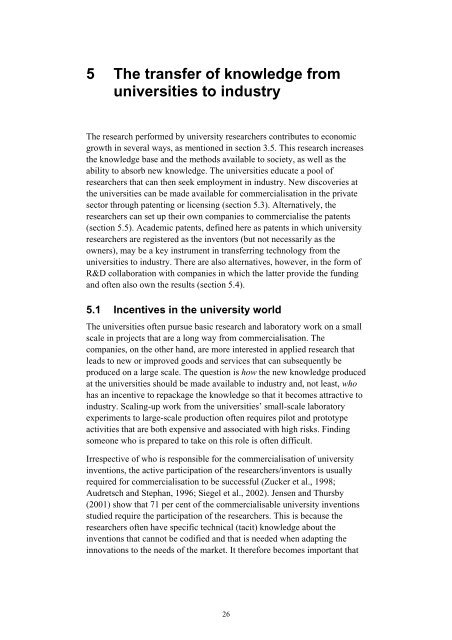Growth through Research and Development - what does ... - Vinnova
Growth through Research and Development - what does ... - Vinnova
Growth through Research and Development - what does ... - Vinnova
You also want an ePaper? Increase the reach of your titles
YUMPU automatically turns print PDFs into web optimized ePapers that Google loves.
5 The transfer of knowledge fromuniversities to industryThe research performed by university researchers contributes to economicgrowth in several ways, as mentioned in section 3.5. This research increasesthe knowledge base <strong>and</strong> the methods available to society, as well as theability to absorb new knowledge. The universities educate a pool ofresearchers that can then seek employment in industry. New discoveries atthe universities can be made available for commercialisation in the privatesector <strong>through</strong> patenting or licensing (section 5.3). Alternatively, theresearchers can set up their own companies to commercialise the patents(section 5.5). Academic patents, defined here as patents in which universityresearchers are registered as the inventors (but not necessarily as theowners), may be a key instrument in transferring technology from theuniversities to industry. There are also alternatives, however, in the form ofR&D collaboration with companies in which the latter provide the funding<strong>and</strong> often also own the results (section 5.4).5.1 Incentives in the university worldThe universities often pursue basic research <strong>and</strong> laboratory work on a smallscale in projects that are a long way from commercialisation. Thecompanies, on the other h<strong>and</strong>, are more interested in applied research thatleads to new or improved goods <strong>and</strong> services that can subsequently beproduced on a large scale. The question is how the new knowledge producedat the universities should be made available to industry <strong>and</strong>, not least, whohas an incentive to repackage the knowledge so that it becomes attractive toindustry. Scaling-up work from the universities’ small-scale laboratoryexperiments to large-scale production often requires pilot <strong>and</strong> prototypeactivities that are both expensive <strong>and</strong> associated with high risks. Findingsomeone who is prepared to take on this role is often difficult.Irrespective of who is responsible for the commercialisation of universityinventions, the active participation of the researchers/inventors is usuallyrequired for commercialisation to be successful (Zucker et al., 1998;Audretsch <strong>and</strong> Stephan, 1996; Siegel et al., 2002). Jensen <strong>and</strong> Thursby(2001) show that 71 per cent of the commercialisable university inventionsstudied require the participation of the researchers. This is because theresearchers often have specific technical (tacit) knowledge about theinventions that cannot be codified <strong>and</strong> that is needed when adapting theinnovations to the needs of the market. It therefore becomes important that26
















